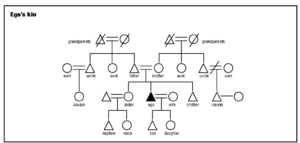Read this article to learn about Kinship types and Importance
Kinship is one of the most important organizing components of society. From east to west or north to south, you will find this everywhere in society. This social institution ties individuals and groups together and establishes a relationship between them.

The basic type of bond is marriage and reproduction. Kinship refers to a bunch of relationship and relatives, these are based on blood relationship (consanguineal) or marriage (affinal)
Some basic definitions by different people:
“The social relationships deriving from blood ties ( real and supposed) and marriage are collectively referred to as kinship.”
– Abercrombie et al
‘Kinship is the recognition of relationships between persons based on descent or marriage. If the relationship between one person and another is considered by them to involve descent, the two are consanguine (“blood”) relatives. If the relationship has been established through marriage, it is affinal.’ – L. Stone
Types of Kinship
The kinships are based on two broad aspects 1) Birth (Blood relationships) 2) marriages
- Consanguineal kinship: this kinship is based on blood the relationship meaning the relationship between parents and children also among immediate siblings. It is said to be the basic and universal in relationships.
- Affinal kinship: this kinship is based on marriage. The relationship between husband and wife is the basic kin relations.
Kinship and its degree:
The relationship among individuals or people depends on the level of closeness and separation of its relationship. Closeness and distance are based on how these individuals are related to each other.
Primary Kinship
Primary kinship is based on direct relations. Individuals or people that are directly related are said to be primary in nature. Primary kinship is further divided into two:
Primary consanguineal kinship: this kin refers to that kin that is directly related to each other by birth. For instance association with or amongst parents and children and among siblings.
Primary Affinal kinship: the relation that takes place with marriage is said to be Primary Affinal kinship. The direct primary affinal kinship is the husband-wife relationship.
Secondary kinship
Secondary kinship alludes to the primary kinship. As it were, the individuals who are specifically identified with primary kinship (i.e. primary kin of our primary kinship) become secondary kinship. In other words, it means relations that come through primary kinship are said to be secondary kinship.
There are two types of Secondary kinship:
Secondary Consanguineal kinship:
This kind of kin refers to primary consanguineal kinship. The basic example of secondary consanguineal kinship would be the relationship between grandparents and grandchildren.
Secondary Affinal kinship:
This kind of kinship refers to primary affinal kinship primary kinship. For example, Anita’s husband is her primary affinal kinship and for Anita’s husband, her parents and siblings are his primary kin. Therefore meaning the relationship between Anita and her sister in law/ brother in law or parents in law and more vice versa is said to be Secondary Affinal kinship. Also, your sibling’s spouse and his/her parents in law will be his secondary affinal kinship.
Tertiary kinship:
Tertiary kinship is the secondary kinship of our primary kin or primary kin of our secondary kinship. For example, wife of our brother in law would be related to us as tertiary kin.
Tertiary kinship is further divided into two:
Tertiary consanguineal kinship:
An example of tertiary consanguineal kin would be our primary consanguineal kins (i.e. our parents) primary kins (i.e. our parents’ parents meaning our grandparents) primary kins. (i.e. our grandparents’ parents)
Tertiary Affinal kinship:
It means primary affinal kins primary kin or secondary affinal primary kin or primary affinal kins secondary kin. For example our spouse’s grandparents or grand uncles and aunties.
Descent: it refers to the socially existing recognized biological relationships between people in society. Every society looks at the fact that all offspring and children descend from their parents and usually it is said biological relationship exists between parents and children. Therefore descent is used to traces an individual’s ancestry.
Lineage: it refers to the line from which descent is traced. This is done by looking into fathers’ line or mothers line or from both the lines. Descent and lineage work together.
Importance of Kinship:
- The kinship system maintains unity, harmony, and cooperation among relationships.
- Kinship sets guidelines for communication and interactions among people.
- Where marital taboo exists decides who can marry whom.
- Kinship regulates the behaviour of different kin.
- Kinship act as a watchdog of social life.
- In rural areas or in the tribal society kinship defines the rights and obligations of the family and marriage also the system of production and political power.
- It helps people to better understand their relationship with each other.
- It builds and develops and helps better relate to one another in society.
Also Read: Understanding Key Concepts in Kinship
Hello, I am Samreen Sagheer pursuing Journalism and Mass Communication from Amity. I am an aspiring writer, ready to give my best. I like to keep things simple and straightforward just like my personality.
